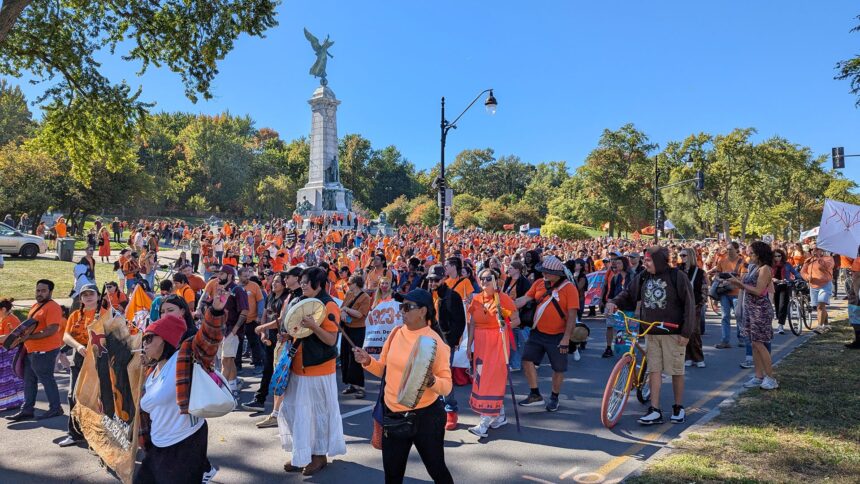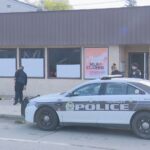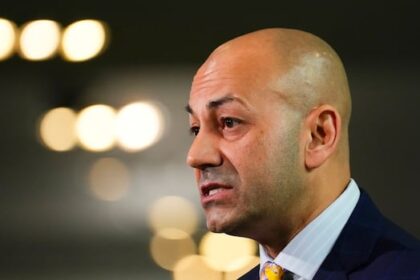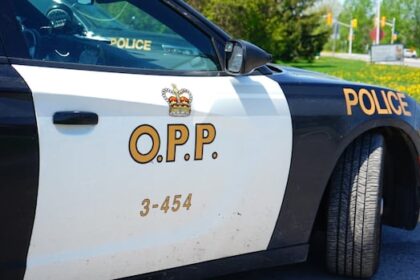In the bright afternoon sun, a large crowd gathered to hear speakers mark the legacy of residential schools, and to march through downtown to Premier François Legault’s office. Fay Virginia Desjarlais participated in the event as a translator and a walker, but like many in the crowd she had a traumatic story of her own that helped bring her there. It started with her name. She told APTN News she was born and named Fay to parents from Muskowekwan and Pasqua First Nations in Saskatchewan. Her mother, a residential school survivor, put her up for adoption during the Sixties Scoop. She subsequently grew up in Quebec in two adoptive families. “My legal name is Elisa Garnier,” said Desjarlais. “But when I met my mother in 2007, she called me Fay, because that’s the name she gave me. She passed away not long after that. So, during a ceremony, I decided that people would call me Fay to honor my mother, who had to leave her children and then live with the trauma associated with that.” She said growing up in Sherbrooke, Que., she and her sister were the only Indigenous people around and certainly the two survivors of the Sixties Scoop. “When I was growing up, we didn’t talk about that,” she said. After she moved to Montreal in the 2000s and began to work with Québec Native Women where she said she learned about the experiences she shared with other Indigenous women. “At the time, I didn’t know that these were assimilation measures designed to strip us of our culture and identity,” she said. “I didn’t know that. It opened my eyes. That’s what led me to go and find my mother.” Today, she works with incarcerated women, as well as women living without housing and doing sex work. She said serving women in need is a tribute to her mother. “When I met her in 2007,” she recalled, “when she talked about what she had been through, she was told she wasn’t a good mother. That’s often what I hear in these stories.” National Day for Truth and Reconciliation event in Montreal’s Mount Royal Park. Photo: APTN News/Jesse Staniforth Courtney Papigatuk, from Salluit, Nunavik, marched with her cousin Courtney Ray from Kahnawake Mohawk Territory. “We’ve all lost people,” Papigatuk said. “It’s true that every child matters, and it’s apparent that not everyone thinks so, so we’re here to let people know.” Ray said it’s important that Sept. 30 remain a day of memorial to the children who didn’t come home from residential schools, but also to those who live with inherited trauma from a genocidal system that attempted to destroy many generations of Indigenous families. “It’s representative that we’re still here, and we’re not going anywhere,” Ray said. “My grandmother was in Indian Day School in Kahnawake, and she actually lost her language. She lost her culture, and the thing that most people don’t really know about is it affects people that are still living.” Ray said she was comforted to see Elders in the front of the march for the first time ever, riding on a float to reduce the strain associated with walking. “It’s really symbolic because they get to see that there’s still community and non-Indigenous people standing for this important matter,” she said. “We’re still finding unmarked graves, and more and more people are connecting with their culture and really understanding that… it’s an emotional time, and we need to stand together.” Read more: 5 years after her death, some say Joyce’s Principle is no closer to being implemented Papigatuk said her mother’s family was deeply traumatized by the loss of her great-grandparents, each of whom were Residential School Survivors who died by suicide. “It’s a very real thing that some people are survivors,” she said, “but they grow up with that on their backs, and they can’t take it. And that’s passed down from generation to generation. My mom is still traumatized from it, and it hurts me because I love them all so, you know?” National Day for Truth and Reconciliation marchers descent Montreal’s Av. du Parc. Photo: APTN News/Jesse Staniforth Thanakehrahne Kirby, who grew up between Akwesasne and Kahnawake Mohawk Territories, marched holding the Two-Row Wampum, symbolic of the agreement his ancestors made with Europeans to travel upon the same river without impeding one another’s progress. “This agreement is that we go down the same river of life and that we are one people, that we are human,” he said. “That agreement was broken. The two-row was broken. The agreements that we had were broken, and we have to rekindle these agreements that we made with each other.” He said he owes his connection to his culture to the willingness of his ancestors to fight to protect their people. “When [my grandmother] had my mother,” he said, “she was out of it a little because of having her first child. This woman tried to come in from the Salvation Army, or one of these organizations, to try and get her to sign this paper, which would have taken my mother away. And my grandmother had to end up saying, ‘No, no!’ “The next day, she got a ride from one of my grandmother’s aunties, and she escaped. But I wouldn’t have been here because my mom would have been taken and assimilated.” Today, Kirby speaks his language and recounts the history and beliefs of his people with ease. He is part of the Mohawk Warrior tradition. “It’s not that we are terrorists,” he said. “We are protecting the voices that can’t be spoken for. We have to advocate for the four-legged beings. We have to advocate for the trees. We have to advocate for all of creation and speak for them because we have to acknowledge and give thanks to the medicines that come from the ground and the natural earth. Our language describes that Mother Earth holds us and our bodies.” Desjarlais said she sees the urban Indigenous community in Montreal growing, but notices their needs are growing too. “There’s a lot of work to be done,” she said. “The community in Montreal is 40,000 people strong. The needs are growing. Many people are coming to Montreal, to cities everywhere.” For Desjarlais, the day’s expression of togetherness was also an expression of need from a community more likely than any other to live in poverty. “Funding for services, for more employees—it’s important that the government opens its eyes and provides the funding we need to continue providing services that will help the community and create less chaos in the city center.” Continue Reading
Weve all lost people: People gather in Montreal to reflect on residential schools

Leave a Comment











